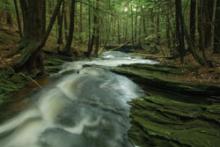You are here
New Harvard Forest Publication: Effect of Observers on Estimates of Infestation of Invasive Species

The growing threat posed by invasive species has focused increased attention on the importance of documenting the spread of introduced organisms. However, labor-intensive surveys are often required to monitor populations of invasive species and thus methods have been developed to estimate the true extent of an invasion using a sample of sites. In a new publication, postdoctoral fellow Matt Fitzpatrick and colleagues including Senior Ecologist Aaron Ellison, use surveys for the hemlock woolly adelgid to show that estimates of infestation rates can be highly sensitive to, and biased by, how much experience individuals have in surveying sites for the organism of interest, particularly when populations are small and easiest to eradicate. Taken together, the study underscores the importance of adequate training of individuals taking part in monitoring programs and the need to document and account for interobserver variation in estimates of infestation rates.
Fitzpatrick, M.C., E.L., Preisser, A.M. Ellison and J.S. Elkinton (2009) Observer bias and the detection of low-density populations. Ecological Applications 19(7): 1673-1679.

